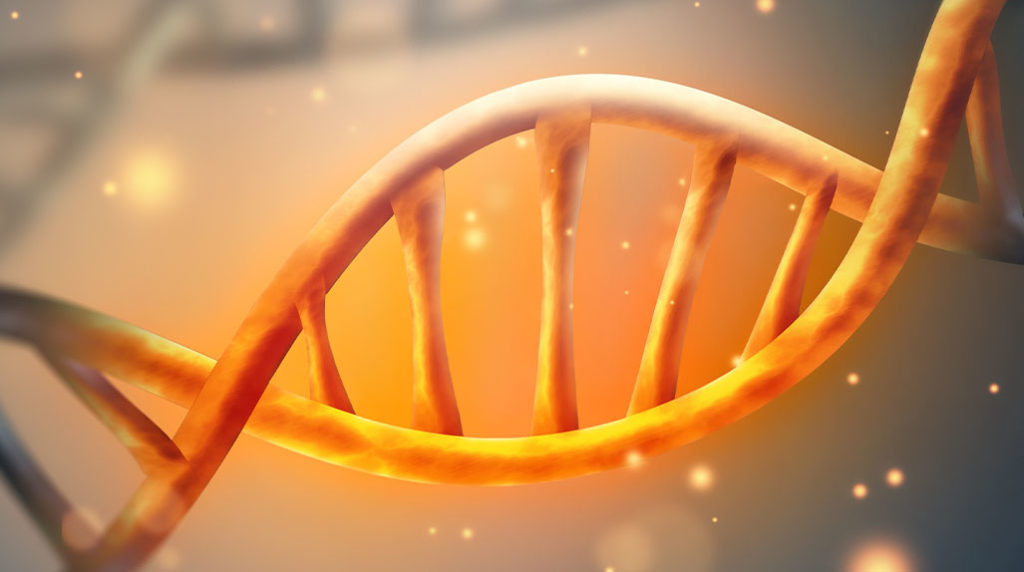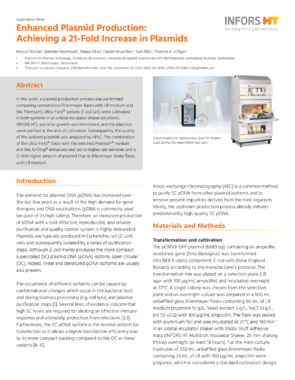Application Note | Authors: Marcel Blanke, Jennifer Redmond, Maike Otto, Daniel Bruecher, Sam Ellis, Thomas K. Villiger1
A plasmid DNA production process was performed comparing conventional Erlenmeyer flasks with LB medium and the Thomson’s Ultra Yield® system. E. coli cells were cultivated in both systems in the INFORS HT Multitron incubator shaker, bacterial growth was monitored, and the plasmids were purified at the end of cultivation. Subsequently, the quality of the isolated plasmids was analyzed by HPLC. The combination of the Ultra Yield® flasks with the enriched Plasmid+® medium and the AirOtop® enhanced seal led to higher cell densities and a 21-fold higher amount of plasmid than in Erlenmeyer shake flasks with LB medium.

Introduction
The demand for plasmid DNA (pDNA) has increased over the last few years as a result of the high demand for gene therapies and DNA vaccinations (pDNA is commonly used because of its high safety). Therefore, an efficient plasmid DNA manufacturing process with increased production of pDNA, with a cost-effective, reproducible, and reliable plasmid DNA purification and quality control system is highly demanded. Plasmids are typically produced in Escherichia coli (E. coli) cells and subsequently isolated by a series of purification steps. Although E. coli mainly produces the more compact supercoiled (SC) plasmid DNA (pDNA) isoform, open circular (OC), nicked, linear and denatured pDNA isoforms are usually also present.
The occurrence of different isoforms can be caused by conformational changes which occur in the bacterial host and during biomass processing (e.g. cell lysis) and plasmid DNA purification steps. Several lines of evidence indicate that high SC levels are required for eliciting an effective immune response and ultimately, protection from infections. Furthermore, the SC pDNA isoform is the desired isoform for transfection as it allows a higher transfection efficiency due to its more compact packing compared to the OC or linear variants. Anion-exchange chromatography (AEC) is a common method to purify SC pDNA from other plasmid isoforms and to remove present impurities derived from the host organism. Ideally, the upstream production process already delivers predominantly high-quality SC pDNA.
Materials and Methods
Transformation and cultivation
The pCMV3-GFP plasmid (6883 bp) containing an ampicillin resistance gene (Sino Biological) was transformed into NEB 5-alpha competent E. coli cells (New England Biolabs) according to the manufacturer’s protocol. The transformation mix was plated on a selection plate (LB agar with 100 µg/mL ampicillin) and incubated overnight at 37°C. A single colony was chosen from the selection plate and an overnight culture was prepared in a 500 mL unbaffled glass Erlenmeyer flasks containing 50 mL of LB medium (tryptone 10 g/L, Yeast extract 5 g/L, NaCl 10 g/L, pH 7.0 ±0.2) with 100 µg/mL ampicillin. The flask was sealed with aluminum foil and was incubated at 37°C and 180 min–1 in an Multitron incubator shaker with Sticky Stuff adhesive mats overnight (at least 18 hours). For the main culture, triplicates of 250 mL unbaffled glass Erlenmeyer flasks containing 25 mL of LB with 100 µg/mL ampicillin were prepared, which is considered a standard cultivation design.
Triplicates of 250 mL Ultra Yield® flasks containing 100 mL of Plasmid+® medium with 100 µg/mL ampicillin and 0.02% of Antifoam 204 (Sigma-Aldrich) were prepared. Both the standard cultivation system and Thomson cultivation system were inoculated from the overnight culture, with a starting OD600nm of 0.2. The Ultra Yield® flasks were sealed with the AirOtop® Enhanced Seal and the Erlenmeyer flasks with aluminum foil. Flasks were incubated at 37°C at 350 min–1 or 180 min–1 in the INFORS HT Multitron Incubator Shaker (25 mm shaking throw) with flask clamps. Note that Sticky Stuff adhesive mats are not suitable for 350 min–1 and the use of clamps is mandatory. Cultures were grown for at least 24 hours and samples were taken at regular intervals to measure OD600nm over time.
DNA purification
The PureYield™ Plasmid Miniprep System (Promega) was used for plasmid purification. LB cell suspension was used undiluted, Thomson cell suspensions were diluted 9-fold to approximately match the OD value of LB samples. 600 µL was sampled of each cell suspension which was then centrifuged, and the pellet was resuspended in 600 µL nuclease free water. All other subsequent steps were carried out in accordance with the PureYield™ Plasmid Miniprep System quick protocol FB093 for kit A1223 or A1222. The DNA purification was performed by the centrifugation method. The plasmids were eluted with nuclease free water provided with the kit. The DNA concentration and purity of the eluted samples were measured at 230, 260 and 280 nm with a NanoDrop™ 2000/2000c Spectrophotometers (Thermo Fisher Scientific).
Plasmid analysis using HPLC
For plasmid analysis an HPLC 1100 Series (Agilent) with DAD detector 1100 Series (Agilent, G1315B) at 260 nm was used. Samples were measured on a BioPro IEX QF, 100 x 4.6 mm, 5 µm particle size column (YMC, QF00S05-1046WP). 5 µL of each sample was injected and measured in triplicates. The column temperature was set at 35°C. Mobile phase A (20 mM Tris-HCl, pH 7.4) and mobile phase B (20 mM Tris-HCl, 1 M NaCl, pH 7.4) were used to elute the sample in a gradient method with a constant flow of 0.5 mL/min. The gradient was performed from minute 0 until minute 0.7 with mobile phase A (MPA) at 25% and mobile phase B (MPB) at 75%. Starting at minute 0.7 the gradient was applied and the composition from 75% MPB was changed to 100% during 20 minute until minute 20.7 and was kept at 100% until minute 24. At minute 24.01 the composition was changed to 25% MPA and 75% MPB until minute 30 (end of the injection).
Download the Application Note to Read the Results
For this process to be successful, the physical load limit and interior dimensions of the incubator shaker is extremely important. The Multitron Incubation Shaker was selected for experiment because it’s load limit could safely accommodate the flasks at high speeds. The Multitron can hold 45 x 250 mL flasks, with a media and culture mass alone totaling 4.5 kilograms. Considering the additional mass of the tray and flask clamps, the shaker’s minimum load limit should exceed 12 kilograms.

